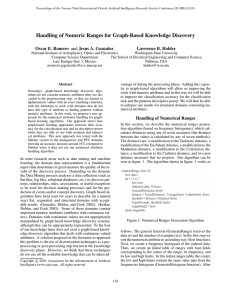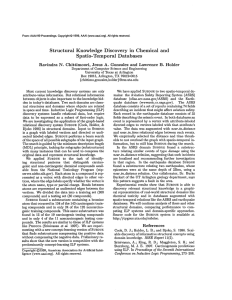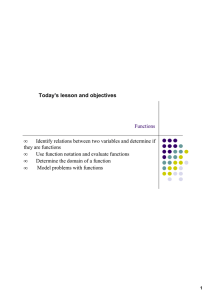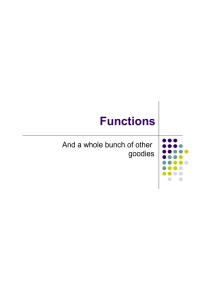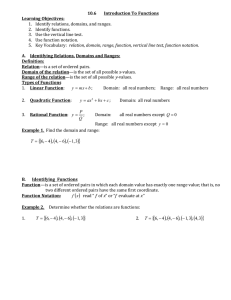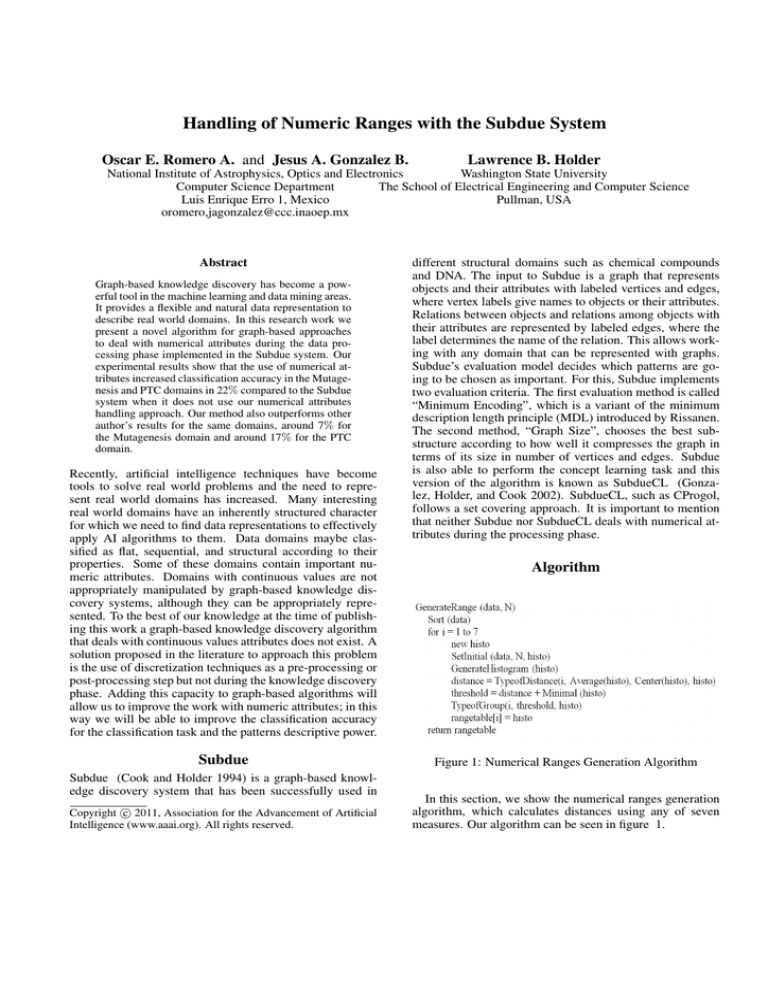
Handling of Numeric Ranges with the Subdue System
Oscar E. Romero A. and Jesus A. Gonzalez B.
Lawrence B. Holder
National Institute of Astrophysics, Optics and Electronics
Washington State University
Computer Science Department
The School of Electrical Engineering and Computer Science
Luis Enrique Erro 1, Mexico
Pullman, USA
oromero,jagonzalez@ccc.inaoep.mx
Abstract
Graph-based knowledge discovery has become a powerful tool in the machine learning and data mining areas.
It provides a flexible and natural data representation to
describe real world domains. In this research work we
present a novel algorithm for graph-based approaches
to deal with numerical attributes during the data processing phase implemented in the Subdue system. Our
experimental results show that the use of numerical attributes increased classification accuracy in the Mutagenesis and PTC domains in 22% compared to the Subdue
system when it does not use our numerical attributes
handling approach. Our method also outperforms other
author’s results for the same domains, around 7% for
the Mutagenesis domain and around 17% for the PTC
domain.
Recently, artificial intelligence techniques have become
tools to solve real world problems and the need to represent real world domains has increased. Many interesting
real world domains have an inherently structured character
for which we need to find data representations to effectively
apply AI algorithms to them. Data domains maybe classified as flat, sequential, and structural according to their
properties. Some of these domains contain important numeric attributes. Domains with continuous values are not
appropriately manipulated by graph-based knowledge discovery systems, although they can be appropriately represented. To the best of our knowledge at the time of publishing this work a graph-based knowledge discovery algorithm
that deals with continuous values attributes does not exist. A
solution proposed in the literature to approach this problem
is the use of discretization techniques as a pre-processing or
post-processing step but not during the knowledge discovery
phase. Adding this capacity to graph-based algorithms will
allow us to improve the work with numeric attributes; in this
way we will be able to improve the classification accuracy
for the classification task and the patterns descriptive power.
Subdue
Subdue (Cook and Holder 1994) is a graph-based knowledge discovery system that has been successfully used in
c 2011, Association for the Advancement of Artificial
Copyright Intelligence (www.aaai.org). All rights reserved.
different structural domains such as chemical compounds
and DNA. The input to Subdue is a graph that represents
objects and their attributes with labeled vertices and edges,
where vertex labels give names to objects or their attributes.
Relations between objects and relations among objects with
their attributes are represented by labeled edges, where the
label determines the name of the relation. This allows working with any domain that can be represented with graphs.
Subdue’s evaluation model decides which patterns are going to be chosen as important. For this, Subdue implements
two evaluation criteria. The first evaluation method is called
“Minimum Encoding”, which is a variant of the minimum
description length principle (MDL) introduced by Rissanen.
The second method, “Graph Size”, chooses the best substructure according to how well it compresses the graph in
terms of its size in number of vertices and edges. Subdue
is also able to perform the concept learning task and this
version of the algorithm is known as SubdueCL (Gonzalez, Holder, and Cook 2002). SubdueCL, such as CProgol,
follows a set covering approach. It is important to mention
that neither Subdue nor SubdueCL deals with numerical attributes during the processing phase.
Algorithm
Figure 1: Numerical Ranges Generation Algorithm
In this section, we show the numerical ranges generation
algorithm, which calculates distances using any of seven
measures. Our algorithm can be seen in figure 1.
Results
In this section we present the most significant results for the
experiments with the Mutagenesis and PTC datasets. In order to show how Subdue can be enhanced when adding it
the capability to deal with numeric attributes, we performed
our first test, in which we did not give it any special treatment to any numerical attribute. With the second test, we
show that the “Subdue” system is able to find interesting
patterns containing numerical values when we generate numerical ranges.
Table 1: Accuracy achieved for the PTC database.
Algorithms
Subdue
CProgol
Type of
Data Representation
Without Ranges
Without Rings
With Ranges
Without Ranges
With Rings
With Ranges
Without Rings
Without Ranges
FM
62%
70%
65%
74%
54%
FR
58%
70%
61%
83%
52%
PTC
MM
66%
74%
69%
78%
53%
MR
54%
64%
57%
76%
55%
MCS
MCES
(Maji and Mehta 2006)
(Maji and Mehta 2006)
72%
73%
79%
79%
77%
77%
75%
73%
Marginalized
(Kashima, Tsuda, and Inokuchi 2003)
63%
67%
64%
63%
Tanimoto
Minimax
(Ralaivola et al. 2005)
(Ralaivola et al. 2005)
64%
65%
67%
66%
66%
64%
66%
65%
We can see the results for the Mutagenesis and PTC
databases in table 2. The behavior of the results for both
representations is similar. We think that by adding rings to
representation “I” (which uses numerical data and some basic relations between its attributes) to create representation
“II” (we add relations based on the rings components) we
should have obtained better accuracy results and more descriptive models (with structural information about rings).
Analyzing our results we can see that when we add structural data to representation “I” to obtain representation “II”,
accuracy increases by 15% (on average) with respect to the
accuracies obtained without using rings. The table shows
the results obtained when we use CProgol with representation “II”. The results that we obtained with CProgol are
slightly inferior (around 3 to 4%) than those reported in
the literature. This might have happened because the background knowledge (or the parameters setting) used in those
other works could be different than those used by us. We
should also consider that the “Subdue” system does not use
background knowledge and that we use the “Subdue” system with limited parameters. We compared the results of the
previous table (Mutagenesis and PTC databases) with the results of other authors (as shown in the same table, last rows).
As we can see, the numerical ranges handling (using numerical and structural data at the same time) that we used with
the Graph-Based system: “Subdue”, increased Subdue’s accuracy with respect to other algorithms. In these results we
can see that our approach obtains an increase of almost 30%
for both, the PTC and the Mutagenesis databases.
Conclusion and Future Work
As our main conclusion we have that the different ways to
generate numerical ranges helped our method to find significant patterns at different levels of abstraction (through our
Table 2: Accuracy achieved for the Mutagenesis database.
Algorithms
Subdue
CProgol
Type of
Data Representation
Without Ranges
Without Rings
With Ranges
Without Ranges
With Rings
With Ranges
Without Rings
Without Ranges
Mutagenesis
42
188
59%
69%
87%
89%
62%
72%
84%
91%
67%
80%
MCS
MCES
(Maji and Mehta 2006)
(Maji and Mehta 2006)
84%
87%
Marginalized
(Kashima, Tsuda, and Inokuchi 2003)
90%
Tanimoto
Minimax
(Ralaivola et al. 2005)
(Ralaivola et al. 2005)
88%
86%
different graph-based data representations) using the Subdue system. We can also note that with our approach to create dynamic numerical ranges we were able to obtain richer
descriptive patterns that were also able to obtain better accuracy for the classification task. This evidence shows that
our novel approach for numerical ranges handling for graphbased approaches is promising. In this way, and as our main
contribution, we created a graph-based approach able to deal
with mixed data types (nominal and continuous) for the concept description and classification tasks. In our future work
we will experiment with different real world domains to take
advantage of our approach. With our new approach we will
be able to perform the data mining task with spatio-temporal
domains.
Acknowledgements
The first author acknowledges Conacyt for the support provided in his doctoral studies with the scholarship number
86997.
References
Cook, D. J., and Holder, L. B. 1994. Substructure discovery using minimum description length and background
knowledge. In Journal of Artificial Intelligence Research,
volume 1, 231–255.
Gonzalez, J. A.; Holder, L. B.; and Cook, D. J. 2002.
Experimental comparison of graph-based relational concept
learning with inductive logic programming systems. In Lecture Notes in Artificial Intelligence, volume 2583, 84–99.
Springer Verlag.
Kashima, H.; Tsuda, K.; and Inokuchi, A. 2003. Marginalized kernels between labeled graphs. In Proceedings of the
Twentieth International Conference on Machine Learning,
321–328. AAAI Press.
Maji, S., and Mehta, S. 2006. A netflow distance between
labeled graphs: Application in chemoinformatics. Undergraduate Thesis. Department of Computer Science of Indian
Institute of Technology, Kanpur 1(1):1–6.
Ralaivola, L.; Swamidass, S. J.; Saigo, H.; and Baldi, P.
2005. Graph kernels for chemical informatics. Neural Netw.
18(8):1093–1110.

